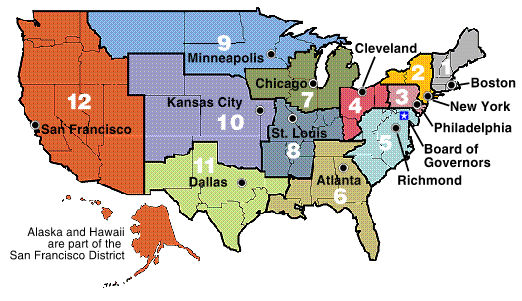|
Wilson's New Freedom Reforms:
Federal Reserve Act for kids
President Woodrow
Wilson, like his predecessors Theodore Roosevelt and William Taft,
was a firm supporter of the
Progressive Movement and
Progressive reforms. His New Freedom polices included the
passing of the US law known as the Federal Reserve Act.
Federal Reserve Act for kids: Background History
The United States of
America had been without a central bank since the charter of the
Second Bank of the United States had expired in 1836. The
Bank War
initiated by Andrew
Jackson brought about the destruction of the
unregulated Second Bank of the United States and the transfer
government money into selected state banks.
Federal Reserve Act for kids: Why was the amendment to the law passed?
The Federal Reserve Act
was passed because public confidence in the US banking system
was extremely low due to the collapse of small banks during periods
of depression in which many Americans had lost their homes,
businesses and life savings. There was no central bank and Wilson
decided to take action to centralize the system, control American
monetary policy and restore the confidence of Americans in banks.
The law became commonly referred to as the Currency Bill.
Who sponsored the
Federal Reserve Act aka the Owen-Glass Act?
The Federal Reserve Act,
aka the Owen-Glass Act, was
sponsored by the chairmen of the House and Senate Banking and
Currency committees by the progressive representatives Carter Glass,
a Democrat of Virginia and Senator Robert Latham Owen, a Democrat of
Oklahoma. The law was passed on December 23, 1913.
What did the
Federal Reserve Act do? What was the Purpose of the Act?
Woodrow Wilson signed the 1913 Federal Reserve Act
into law that established a a Federal Reserve system regulated by a
Board of Governors with the power to set the interest rates the
reserve banks charged other banks. The objectives included the
prevention of financial panics and the ready availability of cash
from a money reserve.
● 12 Federal Reserve banks
were created that served as depositories for the cash reserves
of the banks that joined the system
● The 12 Federal Reserve
banks were governed by a Federal Reserve Board, whose 7 members
were appointed by the President
● The Act gave the Federal
Reserve System the authority to print money and thereby set the
monetary policy of the United States
● Authority was also given
to sell Treasury securities (bonds issued by the U.S.
government)
● Power was given to adjust
the discount rate and the federal funds rate. (The federal funds
rate is the interest rate banks charge each other on loans used
to meet reserve requirements)
● The law further required
that all federally-chartered banks belonged to the Federal
Reserve System and purchased a certain amount of stock in the
Federal Reserve bank
|

Map of the 12
Federal Reserve Districts
|
Map of
the
12 Federal Reserve Districts
The map of the 12 Federal Reserve Districts indicates
by a star the location of the Board of Governors. The Districts are
indicated by number and Reserve Bank city.
1: Boston
2: New York
3:
Philadelphia
4: Cleveland
5: Richmond
6: Atlanta
7: Chicago
8: St. Louis
9:
Minneapolis
10: Kansas
City
11: Dallas
12: San
Francisco
Significance of the
Federal Reserve Act
The Federal
Reserve Act was one of Wilson's most successful enduring legislative
accomplishments - it was landmark
legislation that created the central banking system (the Federal
Reserve). The law assured greater flexibility in the money
supply and provision was made for issuing federal reserve notes to
meet business demands. Before the law was passed the U.S. government
had left control of its money supply largely to unregulated private
banks who often over-stretched themselves prompting periodic
financial panics as investors scrambled to turn their bank paper
into coin. The Federal Reserve Act,
aka the Owen-Glass Act or the Currency Bill, is the most significant
law governing American finances - it has been amended on numerous
occasions and impacts the modern free market economic system in the
United States.
Federal Reserve Act
The info about the Federal Reserve Act,
aka the Owen-Glass Act or the Currency Bill, provides interesting facts and
important information about this important law that
was passed during the presidency of the 28th President of the United States of America.
For further information on banking reforms refer to the
Glass-Steagall Act
aka 1933 Banking Act.
Federal Reserve Act - President Woodrow Wilson Video
The article on the Federal Reserve Act provides detailed facts and a summary of one of the important
progressive reforms and federal laws passed during his presidential term in office. The following
Woodrow Wilson video will
give you additional important facts and dates about the political events experienced by the 28th American President whose presidency spanned from March 4, 1913 to March 4, 1921.
Federal Reserve Act
●
Interesting Facts about Federal Reserve Act for kids and schools
●
Federal Reserve Act aka the Owen-Glass Act or
Currency Bill for kids
●
The Federal Reserve Act, a major
event in US history
●
Woodrow Wilson Presidency from March 4, 1913 to March 4, 1921
●
Fast, fun facts about the Federal Reserve Act
●
Progressive laws and reforms of President Woodrow Wilson
● Woodrow Wilson Presidency and
Federal Reserve Act, aka Owen-Glass Act or Currency
Bill, for schools,
homework, kids and children
|